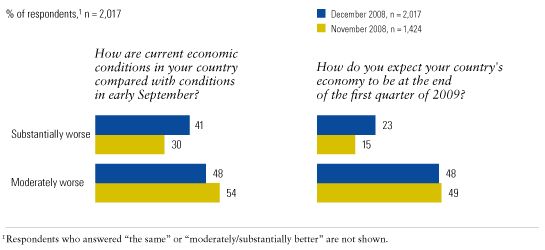Executives have become markedly more pessimistic about their companies’ prospects over the past month, and their already gloomy views on their countries’ economies have intensified, according to a recent McKinsey survey.1 Just over half expect deflation in the first quarter, and the economic downturn appears to have begun hitting developed markets harder over the month, with much higher proportions of executives in those countries saying conditions have gotten “substantially worse.”
With regard to their companies, nearly 70 percent of respondents say they have already seen their profits fall as a result of global turmoil, and half expect profits to fall in 2009. The share of executives saying their companies are planning to decrease the size of their workforces in the near term has risen from 35 percent to 44 percent in the past month.
Nevertheless, some companies—though fewer than a month ago—are still maintaining stability and even finding opportunity in these markets. Smaller and private companies continue to look nimbler and more stable than larger and public ones. And 13 percent of companies overall are contemplating positive strategic moves (such as introducing new products or services to meet new customer needs) and not contemplating any defensive strategies (such as cutting back on capital spending). Respondents in this position are likelier than others to be in North America or at North American companies. That pattern reinforces another finding: executives in North America remain relatively less troubled about their countries’ economies than those in other developed markets.
Companies managing on the edge
In the December survey, 69 percent of respondents say their companies’ profits have decreased over the past six months as a result of economic turmoil (Exhibit 1). Executives in the euro zone are least likely to say so, and those in China likeliest to have taken a hit. Notably, many companies were already weakened six months ago, according to responses to a similar question in June: in that survey, 57 percent of respondents said the US economic slowdown had already had a negative effect on their company.
Nearly two-thirds of respondents to this survey say the main cause of their decreased profits is lower spending by consumers or other businesses. Interestingly, however, most companies did not try to encourage customer spending with price cuts: 55 percent say their companies have held prices steady since early September, and 18 percent have raised them. China is different; there, 40 percent of executives say their companies have lowered prices, though the data don’t show whether that change is a response to lowered profits or a cause of it. Looking ahead, executives appear to expect more of a link between maintaining prices steady in the first half of 2009 and earning higher profits (Exhibit 2).
Sinking profits
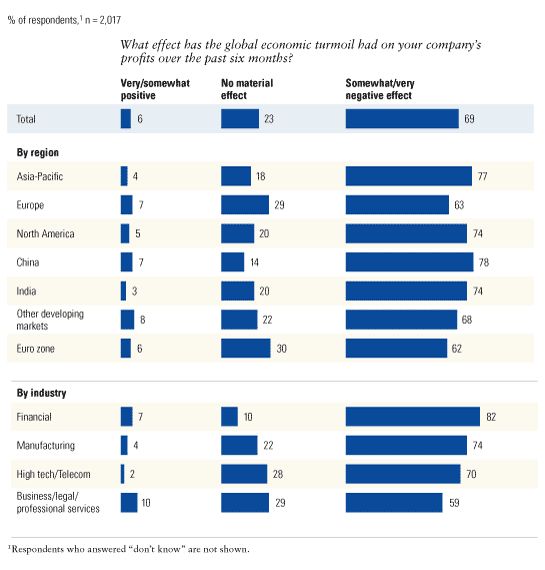
No price change to seek higher profits

Companies do not appear to associate higher profits with decreases in the size of their workforces, likely because of the short-term costs associated with such decreases. But that doesn’t signal good news on hiring. Compared with a month ago, companies have become much likelier to plan on decreasing the size of their workforces in the near term, with 44 percent now expecting to do so (Exhibit 3).
Fewer jobs
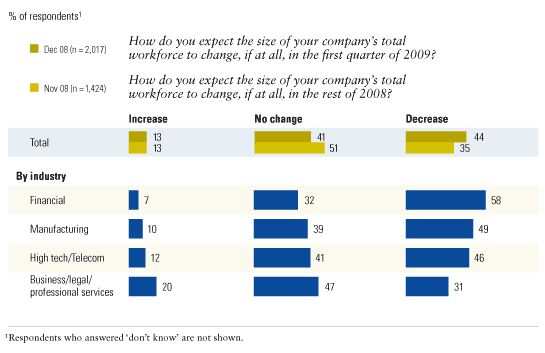
Companies’ plans to decrease their workforces may be more related to a need for cash. Though the proportion of companies that have sought external financing since mid-September remains low, at 26 percent, the figure has increased 5 percentage points in just one month (Exhibit 4). And among those seeking financing, the reason cited more than any other, chosen by 40 percent, is to increase their available cash.
Efforts to increase liquidity
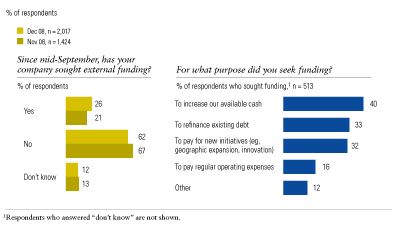
Similarly, when asked how, in light of the economic turmoil, they are adjusting the range of strategic options they consider, executives most often say they have narrowed their options by focusing solely on preserving cash and by cutting back on capital spending (Exhibit 5).
Making adjustments to cope with economic turmoil
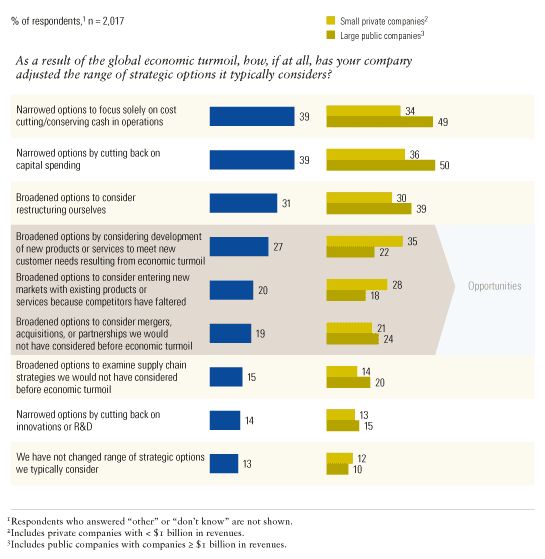
A few bright spots
Some executives continue to see opportunity in turmoil. For example, 27 percent say their companies are considering developing new products or services to meet new customer needs, and 20 percent are considering entering new markets.
Not surprisingly, the 13 percent of executives whose companies are contemplating such positive strategies and not contemplating any defensive strategies describe their companies as better off financially than others: 44 percent have seen stable or increasing profits over the past six months, compared with 29 percent of all respondents. And half expect their profit to increase in the first half of 2009, compared with 27 percent of all respondents. These companies are spread across industries and are of varying sizes. However, executives whose companies are in this group are likelier than others to be in North America or at North American companies. Their relative strength may be related to the fact that, last month and this month, North American executives were likelier than others in developed economies to expect stability or improvement in their countries’ economies in the near term.2 This may suggest that the downturn is working its way first through the economy where it started.
In addition, smaller and private companies continue to look nimbler and more stable than larger and public ones. Compared with large, public companies, they are less likely to be planning to decrease the size of their workforces in the near term. In addition, more have been able to hold prices steady and expect to continue doing so, fewer have seen a negative effect on profits from the economic turmoil, and more expect profits to increase in the first half of 2009.3 Still, the responses suggest one cautionary note for small, private companies: among the small proportion of them that sought external financing, 22 percent were unable to get financing, compared with only 3 percent of large, public companies. So if more small and private companies do begin to face cash flow problems, they may struggle more than others to extricate themselves.
Global gloom
The past month has reinforced executives’ negative views of the near future. Even more executives than in November expect a deep recession, stalled markets, and industry restructuring (Exhibit 6).
In addition, slightly more than half expect deflation to hit their countries in the first quarter of 2009 (Exhibit 7). The executives most likely to expect deflation are in China and the developed countries in Asia.4 (These executives are also the likeliest to say they expect to lower prices in the first quarter, though somewhat more expect to hold them steady.)
Negative expectations on trends
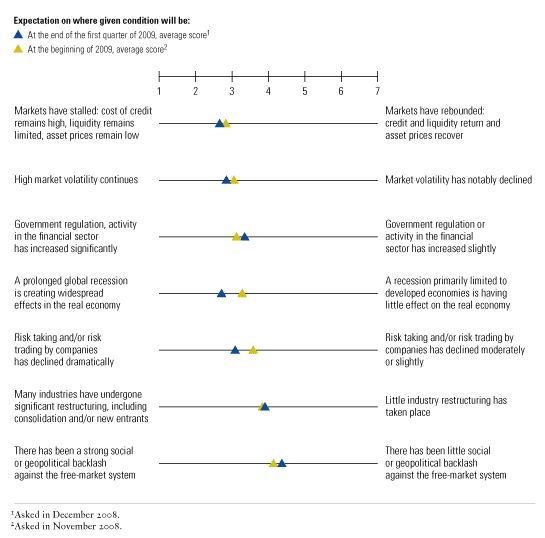
Expecting deflation
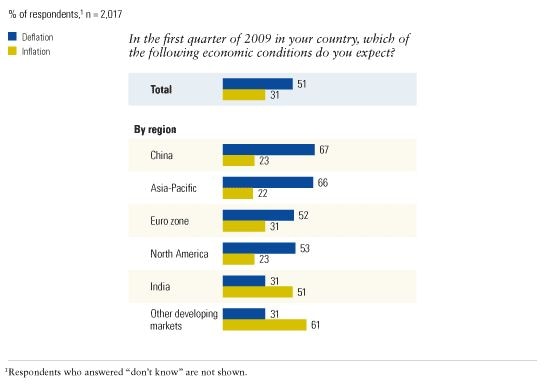
Finally, the proportions of executives saying their countries’ economies are “substantially worse” now than in early September and that they expect their countries’ economies to get “substantially worse” in the near future has risen (Exhibit 8). However, the overall proportion expecting some economic deterioration has risen only slightly. These findings indicate that the economic downturn has started to affect developed markets more deeply in the past month. The relatively high North American expectations for stability are one of the few relatively bright spots. And this month, as in the previous month, executives in China, India, and other developing markets are much likelier than those in developed markets to expect their countries’ economies to improve in the near term.5 This is consistent with the continuing, albeit slower, growth in most of these economies.
A deeper downturn
